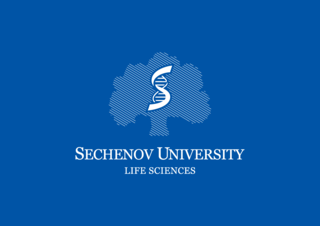
Alexander Mikhailovich Prokhorov was an Australian-born Soviet-Russian physicist known for his pioneering research on lasers and masers in the Soviet Union for which he shared the Nobel Prize in Physics in 1964 with Charles Hard Townes and Nikolay Basov.
An academician is a full member of an artistic, literary, engineering, or scientific academy. In many countries, it is an honorific title used to denote a full member of an academy that has a strong influence on national scientific life. In systems such as the Academy of Sciences of the USSR, the title grants privileges and administrative responsibilities for funding allocation and research priorities.

The Peoples' Friendship University of Russia, also known as RUDN University, is a public research university located in Moscow, Russia. It was established in 1960. The university became an integral part of the Soviet cultural offensive in nonaligned countries.

Nikoloz (Niko) Muskhelishvili was a renowned Soviet Georgian mathematician, physicist and engineer who was one of the founders and first President (1941–1972) of the Georgian SSR Academy of Sciences. He is often referred by the Russian version of his name, Nikolai Ivanovich Muskhelisvili.

Nikolay Gennadiyevich Basov was a Soviet physicist and educator. For his fundamental work in the field of quantum electronics that led to the development of laser and maser, Basov shared the 1964 Nobel Prize in Physics with Alexander Prokhorov and Charles Hard Townes.

The Academy of Sciences of the Soviet Union was the highest scientific institution of the Soviet Union from 1925 to 1991, uniting the country's leading scientists, subordinated directly to the Council of Ministers of the Soviet Union.

First Moscow State Medical University is the oldest medical university in Russia, located in Moscow.

Azerbaijan National Academy of Sciences (ANAS), located in Baku, is the main state research organization and the primary body that conducts research and coordinates activities in the fields of science and social sciences in Azerbaijan. It was established on 23 January 1945.
Angel Balevski is a famous Bulgarian inventor and engineer. Academician Balevski was president of the Bulgarian Academy of Sciences (1968-1987), Co-president of the International Academy of Science, Munich (1988-1997) and chairman of the Bulgarian Pugwash Group.

Evgeny Pavlovich Velikhov is a physicist and scientific leader in the Russian Federation. His scientific interests include plasma physics, lasers, controlled nuclear fusion, power engineering, and magnetohydrodynamics. He is the author of over 1500 scientific publications and a number of inventions and discoveries.
Natalia Petrovna Bekhtereva was a Soviet and Russian neuroscientist and psychologist who developed neurophysiological approaches to psychology, such as measuring the impulse activity of human neurons. She was a participant in the documentary films The Call of the Abyss and Storm of Consciousness, which aroused wide public interest. Candidate of Biological Sciences, Doctor of Medicine, Full Professor.
Victor Efimovich Khain was a prominent Soviet/Russian geology scientist, academician of USSR Academy of Sciences and a number of national and international academies.
Gheorghe Ghidirim is a physician from Moldova and a former Health Minister of Moldova in Mircea Druc Cabinet.

Garib Mammadov Academician-secretary of Department of Agrarian Sciences of Azerbaijan National Academy of Sciences (2011). İs an Azerbaijani scholar and politician serving as the Chairman of State Land and Cartography Committee of Azerbaijan Republic.

Elshan Mahmud oglu Hajizadeh is an Azerbaijani professor, doctor of economic sciences Academician of International Academy of Sciences, an Academician of International Transport Academy, Academician of International Academy of Management, foreign Member of the Russian Academy of Natural Sciences, Member of the International Union of Economists.
Ukrainian medical Lyceum at Bogomolets National Medical University pursuant to its Charter is the state secondary establishment of general education that provides with acquisition of education over state educational minimum, carries out pre-professional education of youth, prepares it to study at higher medical (pharmaceutical) school and to work at health care establishments as junior medical staff.
Walter Kofler is an Austrian physician and philosopher of medicine. Until 2010 he was professor at the Innsbruck Medical University and teaches since 2012 at the I.M. Sechenov First Moscow State Medical University. He is President of the International Academy of Science, Munich.
Vladimir Sokolov was a Russian scientist in the field of zoology and ecology. He was a member of the USSR Academy of Sciences, Russian Academy of Science and the Brundtland Commission. He was one of the pioneers of the Russian environmentalism movement and one of the early global sustainability advocates.

Asaf Hajiyev is the Secretary-General of the Parliamentary Assembly of the Black Sea Economic Cooperation, Former Member of National Assembly of the Republic of Azerbaijan, Doctor of Physical and Mathematical Sciences, Professor, Academician, Chair of Probability Theory and Mathematical Statistics in BSU.
Jamil Aziz oghlu Aliyev is a Doctor of Medicine, Professor, Academician of Azerbaijan National Academy of Sciences, Honored Scientist of the Azerbaijan Republic, Director of National Oncology Center of Ministry of Health of the Republic of Azerbaijan.










